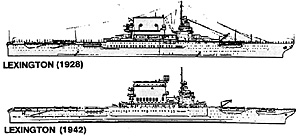Kitbash Corner
Lexington at Coral Sea
by Jimmy Sperling
USS Lexington and Saratoga were perhaps the very first"supercarriers". In an era when the average aircraft carrier had an air group of perhaps thirty planes, they could carry up to ninety. It was during exercises with these two ships that the potential for purely offensive actions by aircraft carriers began to be explored and exploited. Unlike many of their contemporaries (like the Japanese Akagi and Kaga), neither ship required more than comparatively minor modifications to be adequate for use with the new generation of modern aircraft in the 1930s. Most of our readers will know the basic histories of these two ships. They were laid down as two members of what was to be a class of six battlecruisers (though the final design was perhaps closer to that of a "fast battleship") originally provided for in the Navy Act of 1916. Their design was updated several times, most notably due to the Battle of Jutland, when several British battlecruisers blew up due to their thin armor and poor magazine design. The six ships were finally laid down duririg 1920-21, but work on them was stopped due to the Washington naval arms talks in the winter of 1921-22. The terms of the 1922 Washington Naval Treaty forbade the construction of the class, but permitted two of the hulls to be completed as aircraft carriers.
By December 1941 both ships had been altered somewhat from their original configuration- Lexington in particular. "Lady Lex. had had her flight deck widened forward in 1936, and a strengthened light and medium AA suite, along with a CXAM-1 air search radar, had been added by December 1941. Lexington received what were to be her final modifications during a refit in April 1942. She landed her 8 inch turrets, replacing them with three additional quad 1.1 inch light AA mounts. She entered the Battle of the Coral Sea (in which she was sunk) with her original heavy AA suite of twelve 5"/25s and a light AA suite of twelve quad 1.1 inch mounts, thirty-two 20mm guns and twenty-eight .50 caliber AAMGs.
Fortunately, modeling this ship for the Coral Sea engagement is much easier than it used to be. When I started collecting ship miniatures in 1986, the only alternatives I had at the time were either to modify the Superior Lexington in an attempt to rectify dimensional and shape errors and to add details, or to attempt to scratch-build an example. Nowadays the task is infinitely easier with the introduction of the GHQ Lexington (one hopes that eventually they will bring out a wartime Saratoga). Converting the GHQ Lexington is a real breeze. First, omit the four 8 inch gun turrets. Then Cut away the aft control station from the rear of the funnel, retaining the platform underneath. Add two 20mm AA guns to the platform. Next, get three 1.1 inch quad mounts out of your parts box. The GHQ 1942 Pennsylvania can provide spares, or they can be "liberated" from other GHQ ships (by updating them with 40mm quads). Also, GHQ sells components separately, including trees of 40mm and quad 1.1 inch mounts. Place two quad 1.1 inch mounts in superfiring positions aft of the funnel and one on the raised platform just in front of the bridge. Next, cut a 1/8" square of sheet styrene for the CXAM-1 antenna. Glue this antenna to a length of piano wire about 3/16" long, drill a hole through the front of the funnel AA platform and glue the anterma assembly so that the antenna projects just above the front lip of the funnel. Add pairs of .50 cal MGs to the gun platforms fore and aft of the superstructure.
The most difficult problem with the conversion is to find out just what color scheme Lexington was painted in at the time. Looking at the photos I have available, I've narrowed it down to one of two color schemes either Measure 1 (overall Dark Grey) or Measure 11 (overall Sea Blue). One photo taken in October 1941 shows her in Measure 1 with the Measure 5 false bow wave, and the existing photos from the Coral Sea show a rather dark monocolor scheme, but no false bow wave. If anybody out there has any information on the subject to enlighten me and the rest of our readers, please feel free to send us a line.
BT

Taken from U.S. Carriers in Action, Part 1. by Robert Stern, Squadron/Signal Publications, 1991
Back to The Naval SITREP No. 9 Table of Contents
Back to The Naval SITREP List of Issues
Back to Master Magazine List
© Copyright 1996 by Clash of Arms.
This article appears in MagWeb (Magazine Web) on the Internet World Wide Web.
Other military history articles and gaming articles are available at http://www.magweb.com